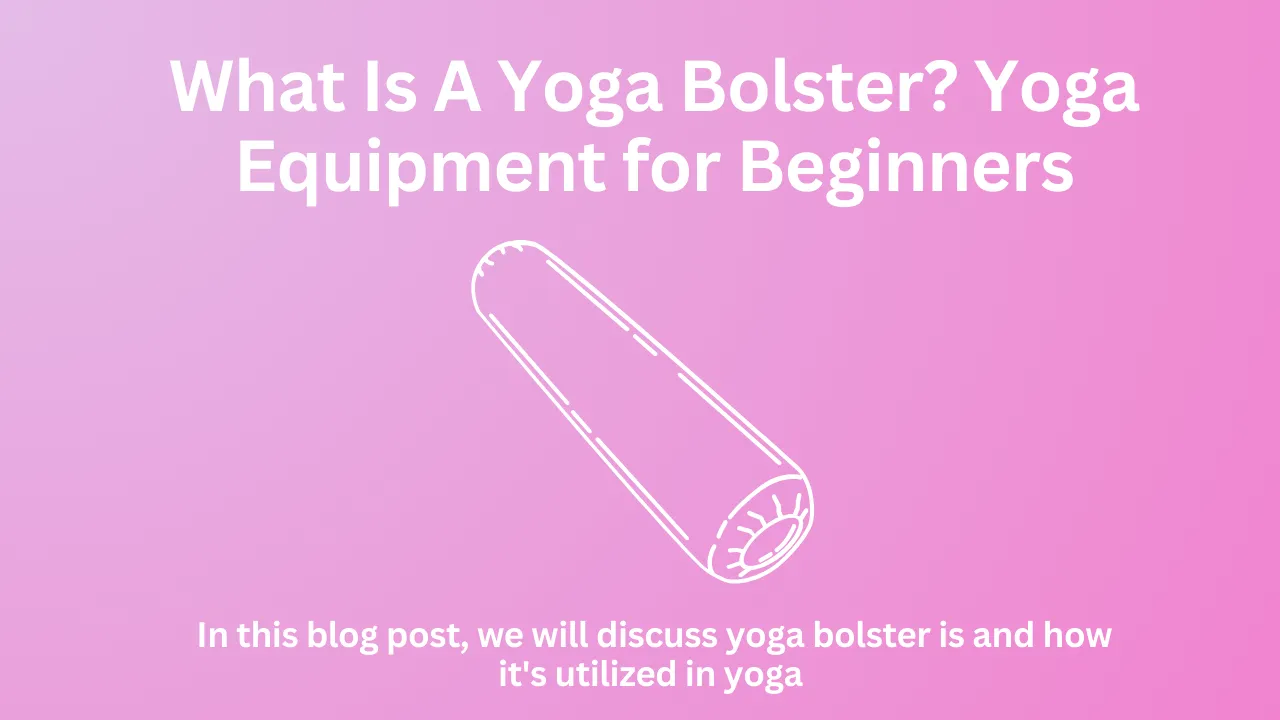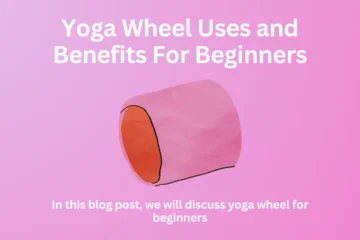What Is A Yoga Bolster? Yoga Equipment for Beginners

Greetings to all newbies to my yoga site, a thorough resource for all a novice in yoga needs to know. We will debunk myths and throw light on what is important in this blog article, which is intended to help anybody who decides to go on a yoga journey stay in shape and composed. We will talk about what a yoga bolster is and how it’s utilized in yoga in this blog article.
A bolster is a thick cushion that provides support. Its purpose is to uphold, fortify, or support your body. Generally speaking, bracers are robust enough to hold your body weight while still being soft enough to lie on. They might be round or rectangular.
What Does a Bloster Contain?
Numerous materials are used to fill boosters. The greatest yoga bolsters still contain cotton batting, as was the custom with these bolsters. However, a lot of businesses use polyester or foam instead of fill to cut expenses. Because these fillers never decompose and might release potentially dangerous off-gases, they are bad for the environment.
The least expensive bolsters are usually filled with polyester. These bolsters are excellent at first, however, when the polyester settles, they may start to feel bumpy and soften after a few weeks. Foam bolsters are typically stiff and have good form retention. They can withstand a lot of wear and tear over time, depending on the foam quality.
The environmental effect of foam is its sole downside. Certain bolsters are packed with hemp goods, feathers, kapok, buckwheat hulls, and loose fabric scraps. These choices frequently don’t offer the best support, even though they are healthier for the environment.
We still think that bolsters made entirely of cotton are the best bolsters for the environment and you! At Love My Mat, we exclusively use 100% cotton fill for our bolsters because of this. To keep you and the soil as supportive as possible, there are no foam or polyester fibers.
The Yoga Bolster: Comfort, Alleviation, and Repose
During yoga, our traditional round or rectangular bolsters help your back relax even more while providing comfort and support. For example, their soft stuffing of spelt husks or cotton makes them perfect for supporting your yoga practice. Their applications are nearly infinite. Whether you use it for rest or to stabilize yourself during challenging poses, the bolster will quickly become your new best friend.
Aesthetically Pleasing, Useful, & Comfortable Home Accent
Bolsters are typically composed of cotton and come in a variety of colors. But the inner life—which frequently comprises things like cotton, buckwheat, or spelled husks—is very significant. When it comes to composition, it’s crucial to strike the correct balance: the ticking should be gentle while still assisting your movements. It should act as a comfortable cushion and a sturdy platform when you’re lying down. A bolster should be around 65 cm in length and 15 cm in height. For comfortable usage, zippers and buttons should be covered.
What Makes a Yoga Bolster Necessary?
With several advantages, a yoga bolster is an excellent tool for your yoga practice. It is an extended, circular, or square cushion made especially to support and align the body during yoga poses. The bolster provides comfortable support and relief for the body, enabling longer and more comfortable holding of certain yoga poses. People with physical or restricted flexibility will find this extremely useful. It allows for safer, more focused execution of the asana without strain or suffering.
Furthermore, using a yoga bolster can aid with posture correction. It assists in relaxing the muscles and lengthening the spine by realigning the body. In particular, this can help avoid back problems. The adaptability of a yoga bolster is an additional benefit. It can be utilized to support the knees, back, neck, or abdomen. It may also be used as a basis for yoga poses like the savasana or as a seat cushion.
Which Size Bolster Is Ideal?
The sizes of bracers vary from little to enormous. Your bolster’s size is entirely up to your choice. The Long & Lean Bolster is my personal favorite.
Because western bodies are prone to be caught in spinal flexion, I devised our Long & Lean Bolster to be 1.5″ narrower and 4″ longer than a typical bolster. Our Long & Lean Bolster measures 28″ in length, 8.5″ in width, and 4.5″ in depth. We believe it’s the ideal size for forward folds, backbends, and all-around support.
- The size of traditional bolsters, which measure 24″ by 10″ by 5″, is still excellent, particularly for restorative yoga.
- The diameter of round bracers can vary from 4″ to 10″. The most popular size is 24″ long by 8″ in diameter.
- Larger restorative boosters provide the most help possible. Typically, these bolsters measure 12″ across, 28″ long, and 6″ deep.
Applicable Times For Yoga Bolster Use?
Yoga boosters are frequently employed in Yin or Restorative Yoga. Nonetheless, they are also utilized in hot, flow, and hatha yoga. The purpose of bolsters is to support you as you do yoga.
My favorite positions to do in yoga using a bolster are:
- Bbacked Savasana
- Supplied Fish Position
- Encouraged Kids Pose
- Lifted Legs Against The Wall
Which Pose Benefits from a Bolster?
One adaptable yoga tool that may be used for a variety of poses is a bolster. In order to promote alignment and support the body during the various asanas, bolsters are employed. The bolster works best for workouts that require prolonged holding. In some passive yoga poses, the bolster can be utilized for a strengthening effect; it can also be employed in some dynamic movements. In restorative or yin yoga techniques, the bolster is frequently utilized.
1. Child Pose
The Supported Child’s Pose is one yoga pose where a bolster comes in handy. The body is bowed forward in a relaxed stance for this exercise. You may easily intensify the stretch in your hips and lower back by putting the bolster below your body and resting on it. The bolster facilitates upper body stabilization, which frees up the body to fully rest.
2. Bridge Pose
The supported bridge pose is another yoga pose that benefits from the use of a bolster. During this exercise, you elevate your pelvis to create a bridge while lying on your back. You can maximize spine support and deepen the stretch in your thighs and hips by putting the bolster beneath your lower back.
Your body can maintain its posture without needless strain or effort thanks to the bolster. It also aids in keeping your posture straight. Your hips are higher than your knees, and you lean slightly forward as you sit on the outermost edge of your bolster. This helps to align your back. Your bolster’s plush stuffing conforms flawlessly to your body.
What Aspects Should I Look for in a Yoga Bolster?
When purchasing a yoga bolster, keep the following things in mind:
A) Size Consideration
One crucial factor in your selection is size. Since bracers come in various sizes, it’s critical to select the appropriate size for both your body type and level of yoga practice. Both an excessively big and uncomfortable bolster might be the result of choosing the wrong size for support.
B) Bolster Support
Is it possible for the bolster to provide excessive support and relief from strain on your neck, back, or other body parts? Verify that the length of the bolster is sufficient to support the desired portions of your body.
C) Material Selection
You must focus on the content as well. Bolster covers come in a variety of fabrics, including linen, cotton, and polyester. Select a material that is comfortable, strong, long-lasting, and has a gentle feel.
1. Cotton
Cotton is a common material because it is supple and permeable.
2. Linen
Because linen offers a premium appearance, it may be seamlessly incorporated into other household furnishings. Additionally, linen is a sturdy and delightfully cool material.
3. Microfiber
Microfibre coverings have improved slip resistance, short drying times, and sweat-wicking properties.
4. Eco-Friendly Options
We provide bolsters manufactured from certified merino wool as well as natural and ecological materials like organic cotton or recycled polyester fibers.
D) Filling & Firmness
The filling utilized has a major impact on the bolster’s hardness and comfort. There are many hardness levels for boosters, ranging from gentle to firm. How hard the bolster is will determine how comfortable and supportive it is. Select a firmer bolster if you’d like a deeper stretch. Select a softer bolster if you’d rather be more comfortable.
1. Foam Bolsters
Foam bolsters frequently offer solid support and good form retention.
2. Organically Spelled Husk
The most localized and natural filler is organic spelled husk, which provides ideal stability and body form adaptation.
3. Cotton-Wadding-Filled
Cotton-wadding-filled boosters are rather light and firm.
E) Detachable Cover Bolsters
Detachable cover bolsters are what we propose. This is a crucial need, particularly if the bolster is used frequently or in a yoga studio. Because it is easier to clean, a bolster with a detachable cover is more practical and long-lasting. Verify whether the cover can be washed in a machine or if manual cleaning is required. To prevent it from getting in the way of your practice, the zipper should be covered.
F) Cost Consideration
Not to mention, the cost plays a significant role in your decision to buy. To obtain the greatest value, compare the costs of several bolsters. But be careful to take into account the bolster’s sustainability, quality, and durability in addition to its price. Generally, the cost varies based on the material and size and is between 40 and 90 euros.
Other Use Cases For A Bolster?
In fact, bolsters have a plethora of additional applications. They may be utilized in a lying, sitting, or stretched position. Bolsters can be employed as recuperation aids and mobility aids. In order to assist people’s therapeutic activities, your physiotherapist’s clinic may use bolsters. When a patient is reclining on their back or their belly, massage therapists frequently place bolsters under the patient’s knee to maintain a neutral spine and comfort.
Different Bolsters Like:
- Lean and Long Bolster
- Conventional Bolster
- Bolster Prana
- Small Round Bolster
- Bolsters made of vinyl
Conclusion
In conclusion, bolsters are really helpful for yoga poses. Furthermore, using a yoga bolster can aid with posture correction. It assists in relaxing the muscles and lengthening the spine by realigning the body. In particular, this can help avoid back problems. The adaptability of a yoga bolster is an additional benefit. It can be utilized to support the knees, back, neck, or abdomen.
It may also be used as a basis for yoga poses like the savasana or as a seat cushion. A yoga bolster may enhance and provide a more enjoyable and soothing experience for every level of practitioner, from novices to experts. Thank you for reading, and please don’t hesitate to contact us with any queries or recommendations. Rest and love be with you.



0 Comments